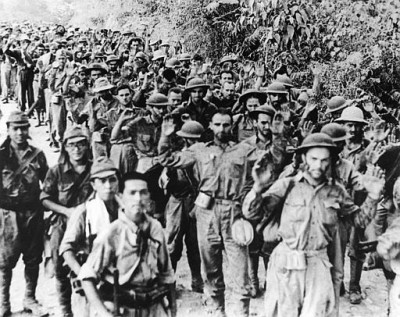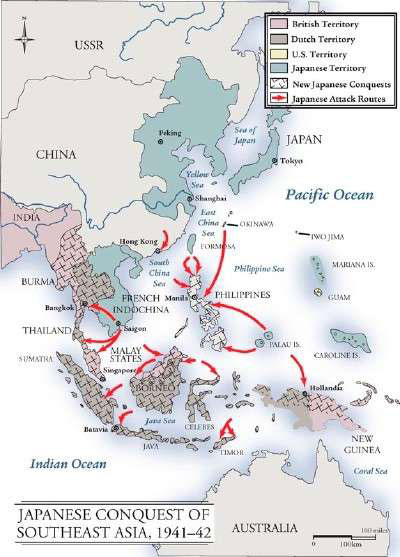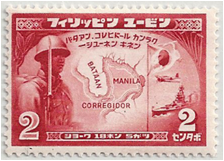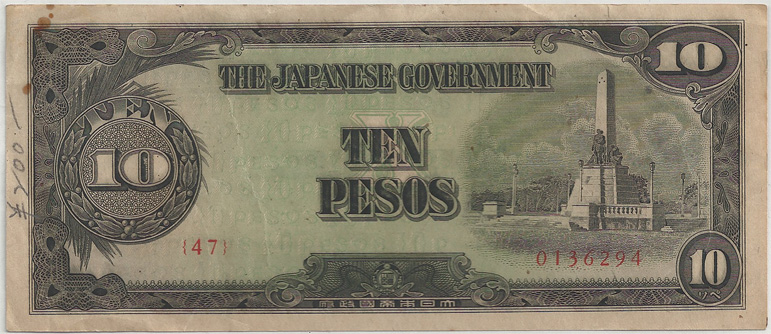ALBUM – view my Japanese Occupation of the Philippines WW2 album
Fast Facts
Region: Far East
Group: Japanese Occupations of WW2
Classification: Military Occupation
Prior Regime: Philippines, US Commonwealth
Key Dates:
1941, Dec 8 – Japanese launch attack on the Philippines
1942, Apr/May – Philippine and American forces surrender in Bataan and Corregidor
1942, Apr/May – Philippine and American forces surrender in Bataan and Corregidor
1943, Oct 14 – Republic of Philippines was declared by the Japanese.
1944, Oct 20 – Allied forces launch an attack to retake the Philippines
1945, Sep 2 – Japanese surrender to Allied Forces, reestablishing the Commonwealth of the Philippines
Following Regime: Philippines, US Commonwealth
Scott Catalogue: (Philippines) N1-N39, NB1-NB8, NJ1, NO1-NO7
Pick Catalogue: (Philippines) 102 – 115
History

These plans were interrupted on December 8th, 1941 when, just ten hours after the attack at Pearl Harbor, Japan launched an invasion on the Philippines. Beginning at Manila, the Japanese quickly overwhelmed the troops on the island under the command of General Douglas MacArthur. American aircraft were destroyed while still on the ground, forcing the U.S. naval fleet, lacking air support, to retreat to Java. The American /Filipino ground troops withdraw to the Bataan Peninsula and the island of Corregidor in Manila Bay. With much of the American Pacific Fleet destroyed in Hawaii, aid would not be forthcoming. On January 2nd, 1942, Manila was declared an “open city” to prevent its destruction and the Japanese marched into the city.
The remaining US/Philippine troops fought until their surrender on the Bataan Peninsula in April 1942 and on Corregidor in May. Over 80,000 prisoners of war were captured by the Japanese at Bataan and were forced to walk to a prison camp more than 100 kilometres to the north in what would be known as the “Bataan Death March”. It is estimated that as many as 10,000 men, weakened by disease and malnutrition, died before reaching their destination.
 The Japanese military authority quickly organized a new government in the Philippines through an established “Council of State”, which directed civilian affairs. After “liberating” the Philippines, the Japanese promised independence for the islands, which was implemented in October of 1943 with the formation of the Republic of the Philippines. While little more than a Japanese puppet government, the appointed President José P. Laurel was never accepted by the populous, and even survived an assassination attempt, being shot 4 times.
The Japanese military authority quickly organized a new government in the Philippines through an established “Council of State”, which directed civilian affairs. After “liberating” the Philippines, the Japanese promised independence for the islands, which was implemented in October of 1943 with the formation of the Republic of the Philippines. While little more than a Japanese puppet government, the appointed President José P. Laurel was never accepted by the populous, and even survived an assassination attempt, being shot 4 times.
During the occupation and the Republic period, a government in exile was maintained and a strong underground resistance and guerrilla movement spread across the islands, which were considered an auxiliary of the American Army. As the tide began to turn in the Pacific, General MacArthur’s Allied Forces launched an attack from Australia, landing on the island of Leyte on October 20, 1944. The Allied forces continued its push to the island of Mindanao and onward to Manila. Aided by the surging opposition and guerrilla forces, the intense fighting continued until the formal surrender of Japan on September 2nd, 1945.
By the end of the war, it is estimated that more than 1 million Filipinos had been killed and the city of Manila was extensive damaged. After the war, the Commonwealth was restored, and after a short transition, elections were held in April 1946, and the Philippines became independent on July 4th, 1946, exactly on schedule.
Stamps
 ALBUM
ALBUM
After the Japanese invasion, postal services reopened on March 4th, 1942 in Manila, extending across other regions over the following months. The first issues were primarily overprinted and surcharged stamps of the Commonwealth. Issues included a commemoration of Japan’s capture of Bataan and Corregidor, the first anniversary of the “Greater East Asian War” and the anniversary of the Philippine Executive Commission. Beginning in April of 1943, 14 definitive stamps with 4 different designs were issued followed shortly with a Commemorative stamp remembering the 1st anniversary of the fall of Bataan and Corregdor.
At the inauguration of the “Republic of Japan”, authorities released a new set of 3 stamps, with the design of a Filipina woman in front of the Rizal Monument and the Philippine flag. These stamps were also issued as a souvenir sheet (the first for the Philippines) and are widely available as first day covers. A few months later, another set of three stamps, featuring Philippine heroes was issued, and also included souvenir sheet.
Toward the end of the occupation, one final set of stamps were issued on January 12th, 1945 depicting President Laurel. In addition to regular postage stamps, semi-postal, postage due, and official stamps were also issued, mostly as overprints and surcharges. The Postal service officially ended in Manila on February 3rd, 1945, when the American Military Forces entered Manila.
Banknotes
 During the occupation, the Japanese government issued fiat currency (currency only backed by national law). The first issues in 1942, were of denominations of 1, 5, 10 and 50 centavos and 1, 5, and 10 Pesos. The next year brought “replacement notes” of 1, 5 and 10 Pesos while 1944 a 100 Peso note and soon after an inflationary 500 Pesos note. Near the end of the war in 1945 the Japanese issued a 1,000 Pesos note. Plates for this note were completed in Manila shortly before U.S. troops entered the city on 3 February 1945, and the Japanese printed the 1,000 Pesos note while they were retreating from Manila to Baguio.
During the occupation, the Japanese government issued fiat currency (currency only backed by national law). The first issues in 1942, were of denominations of 1, 5, 10 and 50 centavos and 1, 5, and 10 Pesos. The next year brought “replacement notes” of 1, 5 and 10 Pesos while 1944 a 100 Peso note and soon after an inflationary 500 Pesos note. Near the end of the war in 1945 the Japanese issued a 1,000 Pesos note. Plates for this note were completed in Manila shortly before U.S. troops entered the city on 3 February 1945, and the Japanese printed the 1,000 Pesos note while they were retreating from Manila to Baguio.
The Japanese-sponsored Second Philippine Republic under Jose P. Laurel outlawed possession of guerrilla currency, and declared a monopoly on the issuance of money, so that anyone found to possess guerrilla notes could be arrested. Some Filipinos called the fiat peso “Mickey Mouse money”, and they were were often used by American psychological warfare personnel as propaganda leaflets. Japanese occupation banknotes were overprinted with the words “The Co-prosperity Sphere: What is it worth?”, in an attempt to discredit the Greater East Asia Co-Prosperity Sphere, and dropped from Allied aircraft over the occupied territories.
Links
The History of the Invasion of the Philippines
Philippines – Stamps and Postal History, Japanese Occupation Stamps
Japanese Invasion Money from Numisnet World





Dear sir:
I have in my possession 7 sheetsX 100 stamps,denomination 25centavos[Japanese occupation Philippines]dated 1943.they are still in good condition,color:light brown.I just want to know how much is the price per sheet?
Hello Mody
Welcome to DCStamps. I honestly I really can’t put a value on stamps, as there are many things that determine value, including finding someone willing to pay for it. I would suggest that you find a local dealer in your area, or check auction sites like eBay.
Good Luck on your search
Michael
Dear michael,
I think my 7 sheets of planting rice 25c pale brown printed 1943 has color errors,2 stamps in the upper left side and 2 others on the lower left side has a greencolor very distinct from the standard pale brown in the rest of the sheets.they are found in all my sheets.1 or 2 nearby stamps exhibit 40% to 5o% green color.can you educate me
Hi Mody
I am not a Philippine Stamp expert (My expertise is more the history). The best place for you to inquire would be the International Philippine Philatelic Society. This is where you will find true experts. You can contact them by going here: http://www.theipps.info/contacts.htm
Good Luck on your search.
Michael
I have six envelopes postmarked (?)(?)olosan.Leyte Jan 19 8AM, with stamps of 8,10,12,16,20 and 1. All except the ’20’ is rectangular of different colors and scenes. The 20 is square greyish/green.
All stamps are overprinted “VICTORY” and ‘COMMONWEALTH.” They are rubber stamped
FIRST DAY COVER
FIRST REGULAR VICTORY STAMPS
SOLD IN REOPENED POST OFFICES
IN THE LIBERATED PHILIPPINES
JANUARY 19, 1945
Are these of any significance? Each letter has addressee’s name cut out.
I appreciate any guidance and/or information on these.
Thanks,
David Leckrone
Appomattox, vA
I have a set of Japanese invasion notes stamped, and I was wondering on their significance. On the perimeter of the stamp is says “The Japanese War Notes Llaimants – Association of the Philippines Inc” and in the middle “Received for Safe keeping”. I am not sure on the Llaimants word because it`s not clear on the stamp.
I would appreciate your feedback on this.
Greetings from Cyprus
Yiorgos
Hi Yiorgos
Nice to hear from Cyprus, thank you for visiting DC Stamps.
The word should be “claimants” not llaimants. You can read more about the stamped bills at http://www.guerrilla-money.com/JIM/JAPWANCAP (or at Wikipedia under Japanese invasion money).
Apparently After WWII, “The Japanese War Notes Claimants Association of the Philippines, Inc.” (JAPWANCAP) was founded in 1953 to pressure the Philippine and U.S. governments to redeem or to pay a fraction of the value of the Japanese military issues of currency for the Philippines. The Association issued a membership and held the notes for a fee. They were never able to reclaim anything after several court cases.
Hope this helps
Michael
I have inherited four copies of an album entitled “Japanese Occupation stamps of the Philippines” The albums are identical and each one is complete, ie no missing stamps. Any comment on their potential value? My grandfather who was interned in Santo Tomas, was a professonal stamp collector.
Hi Finley
I am sorry to hear of your grandfather’s passing away. I am not sure what a “professional stamp collector” is, but it sounds like he must have had quite an extensive collection.
Regarding value of a Philippines complete occupation collection, just like in most things, everything depends on quality. From a catalogue value, a “complete” collection might bring a couple of hundred US Dollars. Realize that far more of these types of stamps were sold to collectors and dealers, than were actually used for postage. If you have any genuine covers (that is entire envelopes actually used as mail), they are probably much rarer and could command a higher price. If you are looking to sell the collections, I would recommend that you find a dealer in your area who could probably give you a good appraisal.
Good Luck
Michael